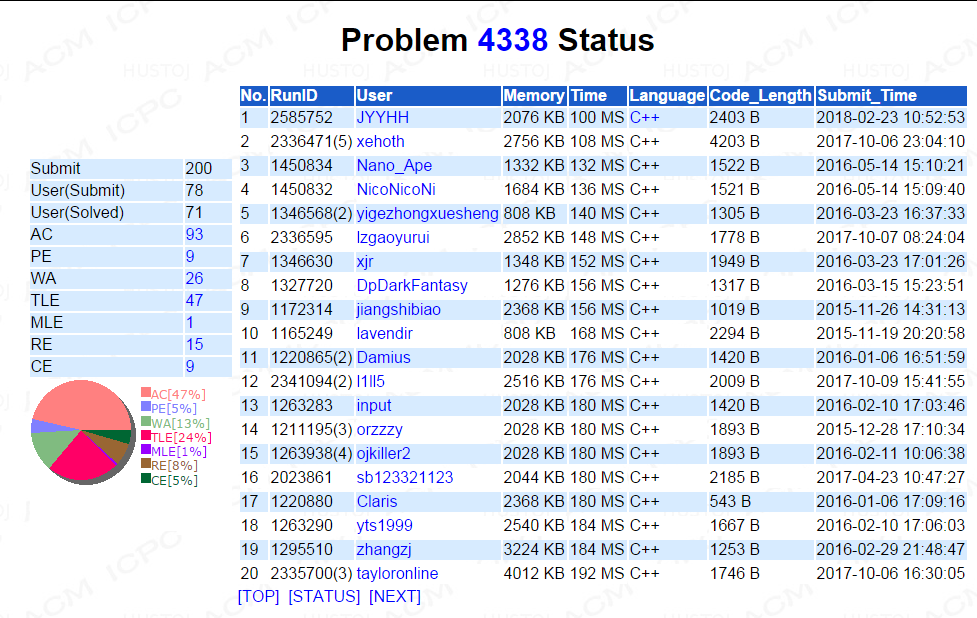4338: BJOI2015 糖果
Time Limit: 2 Sec Memory Limit: 256 MBSubmit: 200 Solved: 93
[Submit][Status][Discuss]
Description
Alice 正在教她的弟弟 Bob 学数学。
每天,Alice 画一个N行M 列的表格,要求 Bob在格子里填数。
Bob已经学会了自然数1到K的写法。因此他在每个格子里填1 ~ K之间的整数。
Alice 告诉 Bob,如果 Bob 填写完表格的 N*M 个数以后,每行的数从第 1 列到第 M
列单调不减,并且任意两行至少有一列的数不同,而且以前 Bob 没有填写过相同的表格,
那么Alice 就给Bob吃一颗糖果。
Bob想知道,如果每天填写一遍表格,最多能吃到多少颗糖果。
答案模P输出。
Input
第一行,四个整数依次是N, M, K, P。
Output
输出一行,一个整数,表示答案模P 后的结果。
Sample Input
【样例输入1】
1 3 3 10
【样例输入2】
2 2 2 10
1 3 3 10
【样例输入2】
2 2 2 10
Sample Output
【样例输出1】
0
【样例输出2】
6
0
【样例输出2】
6
HINT
【样例解释】
样例1。表格只有一行。每个格子可以填写1 ~ 3。有10种填写方法,依次为1 1 1,
1 1 2,1 1 3,1 2 2,1 2 3,1 3 3,2 2 2,2 2 3,2 3 3,3 3 3。
样例2。表格有两行。有6 种填写方法,依次为 1 1/1 2, 1 1/2 2, 1 2/1 1, 1 2/2
2, 2 2/1 1, 2 2/1 2。
【数据规模与约定】
100% 的数据中,1 ≤ N, M ≤ 10^5,1 ≤ P, K ≤ 2*10^9.
没错,这又是扩展卢卡斯+中国剩余定理,是不是已经被我做烂了233333
很容易发现的是一行的方案是可重组合,C(K+M-1,M);
然后因为有N行,行之间不能相同,所以是排列,P(C(K+M-1,M),N)
求一下这个就行了。。。。
然后会发现的是,P可能是一个大质数或者含有一个大质数,所以我特判了一下,如果P中含有大于M的次数为1的质因子的话,那么就直接用组合数的某一行递推公式来算C;否则就用扩展卢卡斯。
至于算P方法都是一样的2333
还有我为什么成了这个题的rank1了,,,(害怕

#include<bits/stdc++.h>
#define ll long long
#define maxn 100005
using namespace std;
int N,M,K,P,MOD;
int d[15],D[15];
int mo,phi[15];
int ans[15],num;
int jc[maxn],inv[maxn];
inline int add(int x,int y,const int ha){
x+=y;
if(x>=ha) return x-ha;
else return x;
}
inline int ksm(int x,int y,const int ha){
int an=1;
for(;y;y>>=1,x=x*(ll)x%ha) if(y&1) an=an*(ll)x%ha;
return an;
}
struct node{
int val,tmp;
node operator *(const node &U)const{
return (node){val*(ll)U.val%D[mo],tmp+U.tmp};
}
node operator /(const node &U)const{
return (node){val*(ll)ksm(U.val,phi[mo]-1,D[mo])%D[mo],tmp-U.tmp};
}
};
inline void dvd(){
for(int i=2;i*(ll)i<=P;i++) if(!(P%i)){
d[++num]=i,D[num]=1;
while(!(P%i)) P/=i,D[num]*=i;
phi[num]=D[num]/d[num]*(d[num]-1);
if(P==1) break;
}
if(P!=1) d[++num]=D[num]=P,phi[num]=P-1;
}
inline node getjc(int x){
node now=(node){1,0};
if(x>=d[mo]) now=now*getjc(x/d[mo]),now.tmp+=x/d[mo];
if(x>=D[mo]) now=now*(node){ksm(jc[D[mo]-1],x/D[mo],D[mo]),0};
now=now*(node){jc[x%D[mo]],0};
return now;
}
inline node getC(int x,int y){
return getjc(x)/getjc(y)/getjc(x-y);
}
inline int getP(int x,int y,const int ha){
int now=x;
for(int i=2;i<=y;i++){
now=add(now,ha-1,ha);
x=x*(ll)now%ha;
}
return x;
}
inline void solve(int x){
mo=x,jc[0]=1;
const int ha=D[x];
if(d[x]==D[x]&&d[x]>M){
inv[1]=1;
for(int i=2;i<=M;i++) inv[i]=-inv[ha%i]*(ll)(ha/i)%ha+ha;
ans[x]=1;
int now=K+M-1;
for(int i=1;i<=M;i++,now=add(now,ha-1,ha)) ans[x]=ans[x]*(ll)now%ha*(ll)inv[i]%ha;
ans[x]=getP(ans[x],N,ha);
}
else{
for(int i=1;i<ha;i++){
jc[i]=jc[i-1];
if(i%d[x]) jc[i]=jc[i]*(ll)i%ha;
}
node now=getC(K+M-1,M);
ans[x]=now.val*(ll)ksm(d[x],now.tmp,ha)%ha;
ans[x]=getP(ans[x],N,ha);
}
}
inline int CRT(){
int an=0;
for(int i=1;i<=num;i++){
mo=i;
an=add(an,(MOD/D[i])*(ll)ksm(MOD/D[i],phi[i]-1,D[i])%MOD*(ll)ans[i]%MOD,MOD);
}
return an;
}
int main(){
scanf("%d%d%d%d",&N,&M,&K,&P),MOD=P;
dvd();
for(int i=1;i<=num;i++) solve(i);
printf("%d\n",CRT());
return 0;
}























 9634
9634

 被折叠的 条评论
为什么被折叠?
被折叠的 条评论
为什么被折叠?








